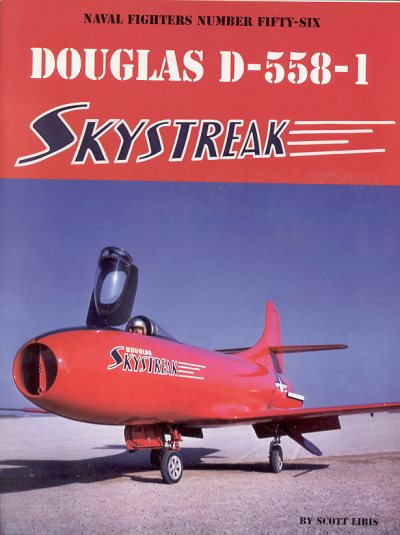|
BOOK: |
Douglas D.558-I
Skystreak |
|
BY: |
Scott Libis |
|
PUBLISHER
/PRICE: |
Ginter books
$15.95 |
|
REVIEW BY: |
Scott
Van Aken |
|
NOTES: |
Naval Fighters #
56 |
 In 1947, the buzz word in the
aviation world was 'speed'. The advent of jet and rocket power meant that planes
would be able to go a great deal faster than what was available with propeller
aircraft. The place for speed was Muroc (later Edwards) in the high desert of
California north of Los Angeles. It was here that Lockheed was trying for a
speed record with the XP-80R (R for race). It was lightened and had a cut down
canopy, but was unable to exceed 600 mph. Putting in an upgraded engine and
increasing the intake size enabled the XP-80R to set a new record at 623 mph.
Lockheed was jubilant. It wouldn't last.
In 1947, the buzz word in the
aviation world was 'speed'. The advent of jet and rocket power meant that planes
would be able to go a great deal faster than what was available with propeller
aircraft. The place for speed was Muroc (later Edwards) in the high desert of
California north of Los Angeles. It was here that Lockheed was trying for a
speed record with the XP-80R (R for race). It was lightened and had a cut down
canopy, but was unable to exceed 600 mph. Putting in an upgraded engine and
increasing the intake size enabled the XP-80R to set a new record at 623 mph.
Lockheed was jubilant. It wouldn't last.
Bell was testing the XS-1
rocket powered aircraft and the Navy was also involved in the need for speed
with Douglas and the D.558-I. This was called the 'Skystreak' as it sounded
sexier than 'D.558-I'. The bright red, straight-winged jet was also called the
'Crimson Test Tube' and the 'Flying Stovepipe' thanks to its nearly straight
fuselage with nose intake. It was designed to investigate the unknowns in the
transonic region between .8 and 1.2 mach. It was here that the demon of
compressibility was to be waiting for the unwary. This phenomena was caused as
air built up along the leading edges of the aircraft and was unable to flow
away, causing buffeting; sometimes with fatal results.
Less than two months after
the XP-80R had set the speed record, the Skystreak mastered it by over 15 mph
averaging 640mph for the average of four runs as required by the rules, with one
run breaking 650mph. Douglas was ecstatic about the event as was the pilot, Cdr
Turner Calwell. Caldwell's jubilation was short lasting as Maj Marion Carl
averaged 650 mph five days later. A few weeks later Douglas test pilot Gene May
raised the ante to 680 mph, almost mach 1 but not quite. Despite all attempts
the Skystreak was only able to break the sound barrier once and that was in
September 1948 when the aircraft was in a long dive. After the X-1 and Chuck
Yeager broke the sound barrier a short while later in November of 1947, the
Skystreak was out of the spotlight and the three aircraft built spent the rest
of their career in 'normal' testing until being withdrawn from use in mid-1953.
Skystreak #1 is at the
Pensacola Naval Aviation Museum, #2 was lost during tests, and #3 is now being
restored after languishing for years outdoors at the Marine Corps Aviation
Museum at Quantico.
Libis book is typical of the
Ginter series. Every bit of information available on the aircraft as well as a
large number of photos are crammed into 66 pages. The only color is on the front
and back page. In addition to all the data and photos there is a modeling
section which covers every known kit of the Skystreak. The plane has not been
well represented with the only kits that could be currently found being the
rather questionable 1/72 Meicraft kit and the equally problematical 1/48
Collect-aire model, which will undoubtedly set you back at least $100.
Like all of Ginters books,
this one is thorough and an excellent reference. I can recommend this one to you
if you have any real interest in the type.
If you would like your product reviewed fairly and quickly by a
site that averages many thousands of visits a day, please contact
me or see other details in the Note to
Contributors.
 In 1947, the buzz word in the
aviation world was 'speed'. The advent of jet and rocket power meant that planes
would be able to go a great deal faster than what was available with propeller
aircraft. The place for speed was Muroc (later Edwards) in the high desert of
California north of Los Angeles. It was here that Lockheed was trying for a
speed record with the XP-80R (R for race). It was lightened and had a cut down
canopy, but was unable to exceed 600 mph. Putting in an upgraded engine and
increasing the intake size enabled the XP-80R to set a new record at 623 mph.
Lockheed was jubilant. It wouldn't last.
In 1947, the buzz word in the
aviation world was 'speed'. The advent of jet and rocket power meant that planes
would be able to go a great deal faster than what was available with propeller
aircraft. The place for speed was Muroc (later Edwards) in the high desert of
California north of Los Angeles. It was here that Lockheed was trying for a
speed record with the XP-80R (R for race). It was lightened and had a cut down
canopy, but was unable to exceed 600 mph. Putting in an upgraded engine and
increasing the intake size enabled the XP-80R to set a new record at 623 mph.
Lockheed was jubilant. It wouldn't last.